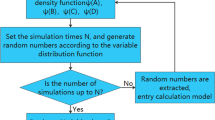Abstract
In order to increase the potential and trend prediction accuracy of unconventional oil and gas resources, a potential and trend prediction method of unconventional oil and gas resources based on combination forecasting model of variable weight for multi-factor is proposed. First of all, the present situation and trend of oil and gas resources development are analyzed and introduced. It is pointed out that it is influenced and restricted by many factors and external environment, which shows the characteristics of its complexity and non-linear historical evolution trend. Secondly, the optimal variable weights are determined by using the variable weight combination forecasting model and then the potential and trend prediction accuracy of unconventional oil and gas resources is realized to be increased. Finally, the validity of the proposed method is verified by the simulation experiment.




Similar content being viewed by others
References
Du, Y., Chen, Y., Zhuang, Y., Zhu, C., Tang, F., Huang, J.: Probing nanostrain via a mechanically designed optical fiber interferometer. IEEE Photon. Technol. Lett. 29(2017), 1348–1351 (2017)
Lv, Z., Halawani, A., Feng, S., Li, H., Réhman, S.U.: Multimodal hand and foot gesture interaction for handheld devices. ACM Trans. Multimed. Comput. Commun. Appl. (TOMM) 11(1s), 10 (2014)
Chen, Y., Tang, F., Bao, Y., Tang, Y., Chen, G.: A Fe-C coated long period fiber grating sensor for corrosion induced mass loss measurement. Opt. Lett. 41(2016), 2306–2309 (2016)
Arunkumar, N., Jayalalitha, S., Dinesh, S., Venugopal, A., Sekar, D.: Sample entropy based ayurvedic pulse diagnosis for diabetics. In: IEEE-International Conference on Advances in Engineering, Science and Management, ICAESM-2012, Art. No. 6215973, pp. 61–62 (2012)
Yijiu Zhao, Y., Hen, H., Liu, J.: Random triggering-based sub-nyquist sampling system for sparse multiband signal. IEEE Trans. Instrum. Meas. 66(7), 1789–1797 (2017)
Arunkumar, N., Ram Kumar, K., Venkataraman, V.: Automatic detection of epileptic seizures using permutation entropy, Tsallis entropy and Kolmogorov complexity. J. Med. Imaging Health Inform. 6(2), 526–531 (2016)
Zhang, Y., Algburi, A., Wang, N., Kholodovych, V., Oh, D.O., Chikindas, M., Uhrich, K.E.: Self-assembled cationic amphiphiles as antimicrobial peptides mimics: role of hydrophobicity, Linkage Type, and Assembly State. Nanomedicine 13(2), 343–352 (2017)
Arunkumar, N., Kumar, K.R., Venkataraman, V.: Automatic detection of epileptic seizures using new entropy measures. J. Med. Imaging Health Inform. 6(3), 724–730 (2016)
Hamza, R., Muhammad, K., Arunkumar, N., González, G.R.: Hash based encryption for keyframes of diagnostic hysteroscopy. IEEE Access (2017). https://doi.org/10.1109/ACCESS.2017.2762405
Abdelhamid, D.S., Zhang, Yingyue, Lewis, D.R., Moghe, P.V., Welsh, W.J., Uhrich, K.E.: Tartaric acid-based amphiphilic macromolecules with ether linkages exhibit enhanced repression of oxidized low density lipoprotein uptake. Biomaterials 53, 32–39 (2015)
Pan, W., Chen, S., Feng, Z.: Automatic clustering of social tag using community detection. Appl. Math. Inf. Sci. 7(2), 675–681 (2013)
Zhang, Y., Mintzer, E., Uhrich, K.E.: Synthesis and characterization of PEGylated bolaamphiphiles with enhanced retention in liposomes. J. Colloid Interface Sci. 482, 19–26 (2016)
Arunkumar, N., Mohamed Sirajudeen, K.M.: Approximate Entropy based ayurvedic pulse diagnosis for diabetics—a case study TISC 2011. In: Proceedings of the 3rd International Conference on Trendz in Information Sciences and Computing, Art. No. 6169099, pp. 133–135 (2011)
Arunkumar, N., Ramkumar, K., Hema, S., Nithya, A., Prakash, P., Kirthika, V.: Fuzzy Lyapunov exponent based onset detection of the epileptic seizures. In: 2013 IEEE Conference on Information and Communication Technologies, ICT 2013, Art. No. 6558185, pp. 701–706 (2013)
Fernandes, S.L., Gurupur, V.P., Sunder, N.R., Arunkumar, N., Kadry, S.: A novel nonintrusive decision support approach for heart rate measurement. Pattern Recognit. Lett. (2017). https://doi.org/10.1016/j.patrec.2017.07.002
Acknowledgement
National key basic research and development plan (2014CB239005).
Author information
Authors and Affiliations
Corresponding author
Rights and permissions
About this article
Cite this article
Yu, H., Rui, L., Zhikun, W. et al. Potential and trend prediction of unconventional oil and gas resources based on combination forecasting model of variable weight for multi-factor. Cluster Comput 22 (Suppl 2), 4571–4577 (2019). https://doi.org/10.1007/s10586-018-2223-y
Received:
Revised:
Accepted:
Published:
Issue Date:
DOI: https://doi.org/10.1007/s10586-018-2223-y




